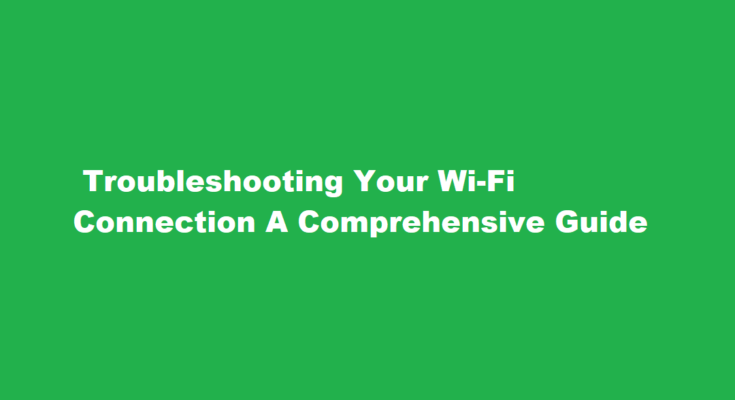Introduction
In today’s digital age, a stable Wi-Fi connection is crucial for work, entertainment, and staying connected with loved ones. However, Wi-Fi issues can be frustrating, often striking at the worst possible moments. In this comprehensive guide, we will walk you through the steps to troubleshoot and resolve common Wi-Fi problems, ensuring a seamless online experience.
Start with the Basics
Before delving into complex troubleshooting procedures, start with the basics
a. Check the Power – Ensure that your router and modem are powered on and properly connected to the electrical outlet.
b. Restart Your Devices – Sometimes, a simple restart of your computer, smartphone, or tablet can resolve connectivity issues.
c. Check for Physical Obstructions – Make sure there are no physical barriers like walls, furniture, or appliances blocking the Wi-Fi signal’s path.
Verify Wi-Fi Network and Password
It’s easy to overlook the simplest things. Double-check that you are trying to connect to the correct Wi-Fi network and enter the correct password. Case sensitivity matters, so be sure your password is entered correctly.
Assess Signal Strength
Weak Wi-Fi signals can lead to slow or intermittent connections. To assess your signal strength
a. Position Yourself Closely – Move closer to the router and see if the signal improves.
b. Interference – Electronic devices like cordless phones, microwave ovens, and Bluetooth devices can interfere with Wi-Fi signals. Ensure your router is placed away from such devices.
c. Channel Selection – Routers broadcast on specific channels, and nearby networks can overlap. Log in to your router’s settings and change the channel to see if it improves the signal.
Restart Your Router
Routers can become overloaded with too many devices or temporary glitches. To resolve this
a. Unplug your router from the power source and wait for at least 30 seconds.
b. Plug it back in and allow it to reboot fully.
c. Reconnect to the Wi-Fi network to check if the issue is resolved.
Update Firmware
Outdated router firmware can cause compatibility issues and security vulnerabilities. To update your router’s firmware
a. Access your router’s web interface using a web browser.
b. Locate the firmware update section and follow the instructions provided by the manufacturer.
c. After the update is complete, restart your router.
Check for IP Address Conflicts
IP address conflicts can occur when two devices on the same network share the same IP address. To resolve this
a. On Windows, open the Command Prompt and enter “ipconfig /release” followed by “ipconfig /renew.”
b. On macOS, go to System Preferences > Network > Wi-Fi > Advanced > TCP/IP and click “Renew DHCP Lease.”
Disable Proxy Settings
Proxy settings can interfere with your internet connection. To disable them
a. On Windows, open the Control Panel, go to Internet Options, and under the Connections tab, click LAN settings. Uncheck the box for “Use a proxy server.”
b. On macOS, go to System Preferences > Network > Wi-Fi > Advanced > Proxies and ensure all proxy options are unchecked.
Investigate Device Issues
Sometimes, the problem might be with your device rather than the Wi-Fi network. Consider the following
a. Update Device Drivers – Ensure that your device’s Wi-Fi drivers are up to date.
b. Disable VPNs or Firewalls – Temporary disable VPNs and firewalls to check if they are causing the issue.
c. Try Another Device – If possible, try connecting another device to the network to determine if the problem is device-specific.
Contact Your ISP
If none of the above steps resolve the issue, it’s time to contact your Internet Service Provider (ISP). They can run diagnostics on their end and may need to send a technician to your location if there are infrastructure issues.
Frequently Asked Questions
How do you diagnose Wi-Fi connection?
On a computer, go to Speedtest.net; on a phone or tablet, download and run the Speedtest app (iOS, Android). Make sure that you’re using your Wi-Fi rather than cellular data and that any VPNs are disconnected. The easiest way to test your connection is to run an internet speed test such as Speedtest.net.
What is basic connectivity troubleshooting?
Check for local connectivity issues: The first step in troubleshooting network errors is to check cables, devices, switches, and routers for proper functioning. Teams can also try restarting devices such as the modem, PC, and router to resolve simple network issues.
Conclusion
A reliable Wi-Fi connection is essential in our interconnected world. By following these troubleshooting steps, you can quickly diagnose and resolve common Wi-Fi issues, ensuring that you stay connected and productive. Remember, patience and persistence are key when troubleshooting Wi-Fi problems, and if all else fails, don’t hesitate to reach out to your ISP for assistance.
Read Also : Troubleshooting The Dreaded Blue Screen of Death (BSOD) in Windows 10



